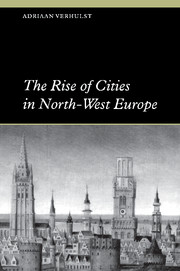Book contents
- Frontmatter
- Contents
- List of maps
- Editor's preface
- Preface
- Map
- 1 The transformation of the Roman towns
- 2 The nadir of urban life (sixth–seventh centuries)
- 3 New urban beginnings and the Viking raids (eighth–ninth centuries)
- 4 The urbanization of the high Middle Ages (tenth–eleventh centuries)
- 5 Industrialization, commercial expansion and emancipation (eleventh–twelfth centuries)
- 6 Conclusion
- Bibliography
- Index
2 - The nadir of urban life (sixth–seventh centuries)
Published online by Cambridge University Press: 05 June 2012
- Frontmatter
- Contents
- List of maps
- Editor's preface
- Preface
- Map
- 1 The transformation of the Roman towns
- 2 The nadir of urban life (sixth–seventh centuries)
- 3 New urban beginnings and the Viking raids (eighth–ninth centuries)
- 4 The urbanization of the high Middle Ages (tenth–eleventh centuries)
- 5 Industrialization, commercial expansion and emancipation (eleventh–twelfth centuries)
- 6 Conclusion
- Bibliography
- Index
Summary
The sixth and seventh centuries constitute a low point in our knowledge of most of the places which may be considered to have had urban or semi-urban characteristics in Roman times. This impression is first and foremost the result of the almost complete absence of written sources dating from that period and of the dearth of archaeological finds and the difficulty of identifying them. Moreover, in many cases the written information we do have about the sixth and seventh centuries relates only to members of the Merovingian aristocracy, to members of the royal house, and in particular to bishops taking up residence or staying in a city of Roman origin with the rank of civitas. Nothing is known about their exact place of residence, save that this was not necessarily always inside the Roman walls. Their presence may have had some economic significance owing to their wealth and their need for luxury and other goods. Centres other than the civitates, probably also with some urban functions, are only mentioned in the context of the activities of missionaries, such as those of St Amand in Ghent and in Antwerp in the second quarter of the seventh century. Even though seventh-century sources, and particularly the numismatic sources, are more numerous, the latter still pose major problems of interpretation. In particular, this applies to their generally accepted but questionable economic significance. Moreover, the accident of archaeological discoveries plays a large role, so that it is very difficult to gauge the importance, and especially the economic importance, of particular places, or of particular regions with a certain concentration of urban centres, within the area under consideration here or indeed within Western Europe as a whole.
- Type
- Chapter
- Information
- The Rise of Cities in North-West Europe , pp. 24 - 43Publisher: Cambridge University PressPrint publication year: 1999

